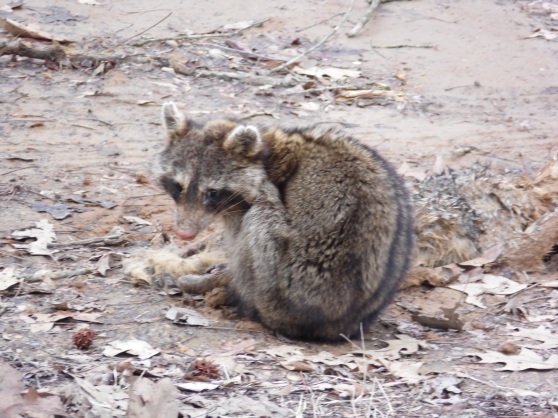*Warning: This post may be upsetting to some. Nothing graphic, but it’s a dreary topic.

This image was taken from my car. I *did not* approach this raccoon. I appear close because of the zoom. I tried to disturb it as little as possible, which is why I only have one poor quality photo.
This is a depressing picture, no doubt about it. But it represents an important truth that we as humans need to know when we trek off into the wilderness: Wild animals can become ill or be injured, and when this happens a normally nonthreatening animal can become a danger to humans.
First, let me tell you about the photo above. I took this picture a few days ago not far from my home. My mother and I were driving into town and spotted this raccoon on the side of the road. He was sitting there licking himself and looking generally listless and did not move even in the time we took to turn around and go back. Anyone familiar with wildlife knows that an animal sitting still in the open in broad daylight near a road is unusual. It’s even more unusual for them to stare at you and make no effort to leave when you stop your car to get a better look.
Whether this little guy was hit by a car and injured or was ill (or even just weird) is unknown. After snapping the picture we called someone to come humanely dispatch him (and take him for testing if he was uninjured), but when they arrived he was gone. He unfortunately remains a mystery.
So why am I depressing you with this sad story? There’s a point! I’m getting to it, I promise.
Most are familiar with Wildlife Safety 101 when it comes to predatory animals like bears, cougars, snakes, sharks, and the like (though I may do a post about that later anyway just to be safe). But the topic of sick and injured animals isn’t brought up nearly as often. However, it should be!
Wild animals are subject to a myriad of illnesses and diseases, and many of those can be given to humans and domestic animals through contact. The big bad that everyone knows about is rabies, and for good reason. Rabies is no laughing matter, and raccoons are the most highly reported carriers of rabies in America. In addition to rabies, raccoons can also carry distemper, salmonella, various parasites, E. Coli, and Leptospirosis. Many of these diseases can be transmitted to pets and/or humans. And that’s just raccoons.
I promise I’m not trying to give you nightmares.
Respect for wildlife must extend beyond respect for predators. Just because Pepe Le Pew wants to eat your popcorn while you’re camping doesn’t mean he won’t go bonkers the next day when he’s hopped up on rabies and itching to share his infection. With that in mind, here are some tips to keep you from needing rabies vaccines and stitches.
- Sick and injured animals are more aggressive. If an animal is acting strange or looks like it’s hurt or sickly, leave it alone. First of all it’s mean to intentionally pester or scare an animal under any circumstances, and second of all you will get yourself bitten or scratched. An animal that is too ill to run away from you will feel cornered, which in the world of flight or fight = fight.
- Be familiar with normal behavior. A raccoon sitting by the side of the road isn’t just chilling. A skunk with a frothing mouth isn’t blowing spit bubbles. Any erratic or unusual behavior from an animal signals that something is not right with it, which signals that you need to keep your distance. Other signs could include a poor coat quality or hygiene, emaciation, or a generally unthrifty appearance.
- Do not approach, touch, or otherwise disturb wildlife for any reason. Why put yourself at risk just so you can say you poked a possum? Wild animals are just that — wild. They aren’t stuffed playthings, they aren’t trained zoo animals doing tricks for you, and they aren’t Fido or Rover. They are creatures whose home you have intruded on and whom may carry any number of nasties that you and your pets don’t want. Respect them and give them their space.
- Do NOT feed the wildlife. Not even the cute ones. (Birds are the only exception.) Feeding wildlife is dangerous for people because it trains said wildlife that people = food. When animals make this association, they are much more likely to come in contact with humans rather than running from them, and animals don’t understand that it’s courteous to stay home when sick. It also increases the animal’s reliance on humans for food and decreases its natural foraging. If it becomes dependent on hand outs it won’t be able to take care of itself when camping season is over.
- Don’t leave your edible trash out. This goes along with number 4. Open trashcans lure animals to your home or campsite, thereby leading them closer to you. Once they recognize you as a food source they will continue to visit.
- Contact the proper officials. If you see a suspicious animal that seems either injured or ill or that is being a nuisance, contact your local animal control or park service. They can determine whether the animal is healthy or not and humanely dispatch it if needed so that it will no longer be suffering and won’t be able to spread any diseases it may have. They can also send the body off for testing if it is exhibiting signs of a serious illness such as rabies, and they are properly equipped to deal with nuisance animals as well.
I’m sorry this post was such a downer, but I thought that this was an important topic to cover and couldn’t get it out of my mind after seeing the raccoon in the picture. Be safe!